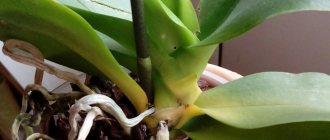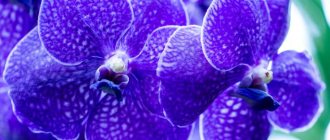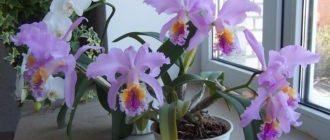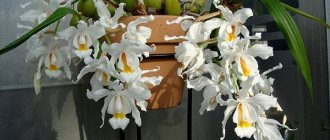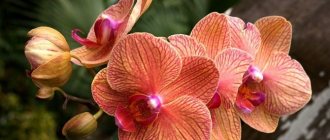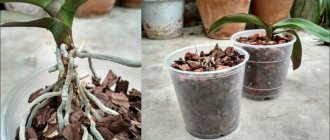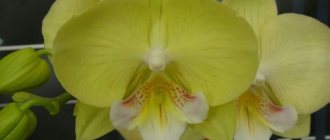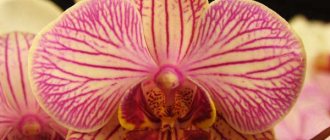Orchids delight gardeners with a variety of shades - white, pink, orange, brown and even black varieties are found in nature. On store shelves you can also find specimens with unusual bright blue petals. The cost of such plants is usually higher. But you shouldn’t rush and buy such a specimen, as you can try to get a blue color from varieties with white buds.
Special varieties
Blue archidea - dyed or natural? There are only two varieties of orchids with an unusual blue color - Vanda and Cattleya. Vanda is a capricious flower and requires special attention. The color is not quite blue - with a purple tint. But Wanda looks no less impressive than painted flowers.
Cattleya is less demanding in care. Features large, bright flowers. The colors are different, and among them there are also varieties with pale blue flowers. Orchids do not have a deep blue color in nature. Flowers are colored by watering or injection with dye. It will not be possible to preserve the blue color - the next flowers will be slightly bluish or completely white.
All the intense blue orchids in the store are painted phalaenopsis. When purchasing a plant, inspect it carefully. If the flower is limp, a bluish tint appears on the roots and leaves, and there is noticeable damage on the stem from the introduction of dye, do not buy it. Such a plant will die very soon.
Transgenic blue phalaenopsis from Japan
In February 2013, the 11th Orchid Conference of the Asia-Pacific region was held in Japan on the island of Okinawa. Masahiro Mii from Chiba University attracted much attention at this conference with his report “Genetic Transformation of Orchids and Production of Transgenic Blue Phalaenopsis.”
Of course, he also presented the real result of many years of experiments by a group of genetic engineers and breeders at Chiba University.
This is Phalaenopsis Aphrodite with white flowers, to which the “blue” gene of the flower of Commelina (popularly blue-eyed), which grows in Asia, was introduced. Phalaenopsis Aphrodite is quite prolific - it can produce up to 30 small flowers with a diameter of 5 cm in one flowering. Blue orchids were presented in nominal and peloric forms.
However, it will not be long before such a genetic engineering product will become available to ordinary flower growers.
Actions after purchase
Care is complicated by the weakened state of the plant. The introduction of artificial dye is a powerful stress for the flower. He will need increased attention and enhanced care so that he can adapt to new conditions.
Do not rush to replant the orchid in a new pot. This is additional stress. There is too high a chance that the flower will die soon after transplantation.
If too many chemical dyes have been introduced, the flower will gradually begin to shed its buds. He needs to be resuscitated urgently. Carefully inspect the plant from peduncle to roots. Look for needle marks. Finding them on the roots is a bad sign. There are no guarantees that the orchid will be saved. The dye was injected into the peduncle - the plant has a greater chance of survival.
Resuscitation of a painted flower
- Find the injection site. And carefully, with a sharp knife, cut off the paint-filled peduncle.
- Remove the orchid from the pot. Free the roots from the substrate. Rinse the root system with warm water.
- Inspect the roots. If you find bluish, rotting areas, cut them out. Treat the cut areas with cinnamon or charcoal powder.
- Dry the roots. During few hours.
- Replant. Into a new sterile substrate.
How to care?
Blue orchids require careful care, proper watering and fertilization.
Top dressing
The flower loves to feed abundantly on minerals, and therefore the plant needs to be fertilized at least 2-3 times a month during the warm period. In autumn, the frequency of feeding can be reduced by 2 times, and in winter it is enough to feed the specimen once a month. One caveat: nutrition through the root system is not enough; the fertilization process must also be carried out along the leaf. Special store-bought mixtures are suitable for this.
Another rule: salts that are used for fertilizer tend to concentrate in the substrate, and therefore it is important to rinse it with warm water once a month. Take advantage of a few more tips on fertilizing phalaenopsis, which are given by experienced gardeners:
- Only healthy specimens with a stable root system and normal leaf turgor are allowed to be fed;
- During the flowering period, plants cannot be fertilized, since this procedure accelerates the metabolism, and accordingly, the flowering duration is significantly reduced;
- during the so-called dormant period, the crop will require feeding once every 2 weeks;
- For a month you cannot fertilize a newly transplanted flower or a young, still weakened specimen;
- follow all proportions specified in the instructions for use of the drug.
When choosing fertilizer for the blue variety in the store, give preference to the following products:
- “Doctor Foley” - due to the nitrogen and potassium content, this mixture has a beneficial effect on the active growth of tissues and the overall development of the plant;
- Forte complexes – the product contains phosphorus, which promotes long-lasting and abundant flowering;
- biofertilizer "Mr. Color" is intended for the growth of leaves and roots, and has a positive effect on the development of flower stalks.
Basic care
A painted flower will require more careful care. Breaking the rules will result in death.
- Lighting. Sunny places are not suitable. On the south side they place it on a table slightly away from the window. Preference is given to the northeast, west and east sides. During the midday hours, be sure to provide shade.
- Temperature. In light shade, at moderate temperatures of 18-25˚C, flowering will last longer. In summer, a short-term increase in temperature up to 35˚C is allowed. Prolonged heat leads to shedding of buds and lethargy of leaves. A plant weakened by dyes may not tolerate heat. In winter, the temperature is reduced to 15-25˚C. Withstands short-term cooling down to 12˚С.
- Humidity. A normal humidity level is considered to be in the range of 30-40%. High humidity and poor ventilation of the room lead to rotting of the roots and the appearance of spots on the leaves. When the humidity is below 20-25%, the leaves lose turgor and the flowers fall off. Careful spraying is beneficial. But try not to allow water to accumulate in the leaf axils.
- Watering. You need to water according to the actual variety of the plant. White phalaenopsis are most often colored, so watering should be regular. Do not allow the soil to dry out completely, but also not allow it to become waterlogged. In phalaenopsis, wet roots become green in color.
- Feeding. It is better not to feed a painted orchid or use a minimal amount of low concentration fertilizer. One of the most successful fertilizers is Kemira Lux.
- Root care. Aerial roots are not buried in the substrate. They are needed to obtain additional moisture and nutrition from the air. Old roots gradually die off - they turn brown and dry out. The dried parts are carefully cut off with a sharp knife.
- Priming. The main substrate component for most orchids is pine bark. In dry rooms, sphagnum is added to the substrate - it retains moisture well. You can add some crushed foam and charcoal. Before planting, the bark is soaked for two days, washed with clean water and only then mixed with the rest of the ingredients.
- Transfer. Don't rush into transferring. It is worth doing this if the roots are damaged or the substrate is in poor condition. Replant after flowering at intervals of two to three years.
Don't be surprised if your blue orchid changes color during its next bloom. The paint is gradually washed out of the plant. Freshly colored flowers are intensely blue; during the next flowering they will be white with blue streaks or slightly bluish. Then ordinary white flowers form on the peduncles.
Growing
The next phalaenopsis flowers will change color to partially blue or completely white. To preserve the plant and wait for the next flowering, proper care is needed. After flowering, you need to cut off the artificially colored flower stem and allow the plant to rest, placing it in a moderately warm room (20-22 °C), a place with diffused light. Watering the orchid should be done systematically, but rarely (the substrate in the pot must be completely dry before adding water again), once every 7-10 days, immersing the pot in a container of water for 0.5-1 hour. After watering, it is necessary to drain the remaining water; moisture around the roots often provokes rotting. During the dormant period, do not fertilize the plants; allow the flower to gradually regain its strength. When the plant looks healthy and is putting out new leaves, you can begin feeding and try to get it to bloom again. To re-bloom, you need to provide the plant with a varied, not high temperature (20-22 °C during the day and 16-18 °C at night), provoking the appearance of buds. The desired effect is obtained by placing the flower in a cold room or taking it outside (to the balcony or garden) for a couple of weeks in early autumn. When cooling the plant, you need to ensure that the ambient temperature does not fall below 15 °C; orchids do not like cold and a short-term drop in temperature below 5 °C will cause serious damage and death. New flowers will be in a natural color - cream or white.
Can a blue or blue orchid exist?
There is a true blue orchid, for example, Vanda blue
(Vanda coerulea), varieties "Pachara Delight" and "Blue Magic". Vanda is a genus of the Orchidaceae family, the family includes Phalaenopsis, Vanda comes in different blue-blue shades, Vanda is not painted, unlike Phalaenopsis.
The blue orchid attracts attention at first sight, causing an irresistible desire to buy this exotic miracle. But not every buyer knows that its unusual beauty is extremely short-lived, and the next flowering will not delight you with its unusual shade
Unfortunately, we have to disappoint you: under natural conditions, orchids simply do not have the gene responsible for the blue pigment. Therefore, there is no need to doubt whether your blue orchid is painted or not. Definitely painted. True, this statement is true only for phalaenopsis. By choosing a vanda flower, you will be able to enjoy your favorite color, but such a crop requires more careful care. You can choose a less whimsical option - cattleya, characterized by a variety of colors and large flowers.
And yet, natural shades are much inferior in brightness to the rich indigo that painted orchids flaunt.
Coloring at home
Why did the blue orchid become a different color, can it be repainted? It is not advisable to paint orchids, since any coloring substance poisons them. As a last resort, use special paints for flowers. They can be purchased at large flower shops or ordered online. The algorithm of actions includes four stages.
- Dilute the paint with water. In accordance with the instructions.
- Take a sterile syringe. And fill it with dye.
- Gently pierce the flower stalk. And introduce the dye solution.
- Treat the puncture site. Coal powder.
At first, carefully monitor the condition of the plant. Keep it in a cool room, in moderate lighting, and monitor the condition of the soil. If the flowers turn blue, do not wilt, and the plant looks healthy, the experiment was a success.
It is not recommended to inject the dye solution into the stem and roots of the plant. The orchid may die from this. Use only special dyes for flowers. Food inks will not give the desired effect; ink will destroy the orchid.
Dye selection
By purchasing an orchid already painted blue at a retail point of sale, the buyer runs the risk of receiving a low-quality product that contains a dye that is very dangerous for the flower. In addition, there may be a fact of non-compliance with painting technology.
To purchase orchids, it is best to visit specialized agricultural fairs rather than regular retail stores. In this case, you need to make sure that you don’t come across a plant that has blue roots and flowers, because it is unlikely to live long.
You need to remember a simple recommendation: immediately after purchasing a flower, you should never try to replant it, since during this period it is most vulnerable.
The most unpretentious plant to care for is Cattleya. It is characterized by the presence of large diameter flowers that spread their fragrance over a long distance.
If you try to paint a plant yourself, all responsibility for the result falls on the shoulders of the plant grower. If you decide to do everything yourself, you can use special paints intended for flowers, or ordinary food coloring. Paints are purchased on specialized Internet sites.
Some people use a dyeing method that is quite cruel to the plant: they take simple ink and apply it directly to the flower. However, painting with ink is strictly prohibited, since ink almost always contains dangerous solvents, penetrants, cleaning agents, etc.
Consequences of color change
Any paint contains aggressive chemicals. Their introduction into the peduncle does not occur without consequences.
- Gas exchange disturbance. The capillaries become clogged and the plant cannot breathe fully.
- Diseases and pests. Natural immunity is lost, resistance to diseases and pests is lost. Sores and rot may appear at the injection site. When dye is introduced into the roots, they inevitably rot.
- Death of the plant. This is the most common outcome of the experiment. At best, it is partially restored, but still remains weakened.
Caring for a painted orchid after flowering will vary slightly. It is better to cut the peduncle immediately, without waiting for the re-formation of buds or children. It will take more time to recover. The flower needs to be provided with the most comfortable conditions.
Painting does not affect the genetic code of the plant in any way. This is a temporary change, of which there will be no trace left by the next flowering. If you want to diversify your collection with a blue orchid, look for Vanda or Cattleya in stores.
Are there blue orchids?
So does the blue orchid exist? Do blue orchids exist or are they painted? The answer is: Vandas and Cattleyas come in blue and soft blue shades.
But those who want to purchase a blue phalaenopsis will have to accept the disappointing truth. Most often, this unique color for orchids hides ordinary ink or dyes.
Most often, white orchids are dyed to produce blue flowers.
If the flowers do not die from chemical poisoning, you should prepare for the fact that during the next flowering the buds will most likely be white. And if Japanese scientists managed to develop a special variety of blue orchid, then they will not reach the CIS countries soon.
Unfortunately, orchids purchased not at specialized exhibitions, but in small stores, are 100% likely to be colored.
If the window sills are already bursting with orchids, all sorts of colors have been collected, and your soul is asking for something exotic, it is better to try painting the orchids yourself. The simplest method, which even a beginner can master, is to inject injections with special paints into the roots or peduncle of a white orchid.
No one is safe from mistakes; dyes can get into not only flowers, but also leaves. A bluish tint can give the plant a sickly, artificial appearance. However, this does not mean at all that the orchid will remain blue forever; with each subsequent flowering, the color will be washed out and, as a result, the inflorescences will take on an absolutely snow-white color.
Wanda
The pioneer of the genus of blue orchids can be called Vanda, the natural queen of this variety. Experts do not recommend purchasing such a plant for beginners, since such flowers are very capricious and require special protection and care.
As practice shows, only experienced gardeners can easily cope with the task of growing blue Vanda.
An important feature of the variety is that the species has a huge number of hybrids of different colors, because it easily survives crossing with other varieties. The resulting unique color scheme is worth all the effort and perseverance spent on growing
Recently, flower growers have noted that this type of orchid, like the blue Vanda, is gaining incredible momentum
The resulting unique color scheme is worth all the effort and perseverance spent on growing it. Recently, flower growers have noted that this type of orchid, like the blue Vanda, is gaining incredible momentum.
Blue Vanda.
Purple Wanda.
Blue Wanda.
Cattleya
Cattleya is the variety most in demand among beginners, since it is less whimsical, unlike Vanda. And the huge, fragrant inflorescences will not leave anyone indifferent. The palette contains many shades of blue flowers, but they are not pronounced, but more delicate.
Cattleya C.Chapmanii coerulea.
Blue Cattleya.
Cattleya comes in nature in soft blue and blue shades.
Phalaenopsis
If you don’t have any time to care for an orchid, but you really want a blue specimen for your collection, you should pay attention to the painted Phalaenopsis. As you know, this variety is the most unpretentious of all possible, takes root well at home and does not require careful care.
The most common variety of blue orchid in stores is Phalaenopsis.
Blue and blue phalaenopsis are the most popular of all the above varieties. Also perfect for those who are allergic to strong odors. Phalaenopsis inflorescences do not smell.
Important! It cannot be said that all the types of orchids listed above have the blue colors that people usually imagine. In fact, they are faint and have a blue tint rather than a bright color.
Reproduction methods
If you bought not a vanda or cattleya, but a painted orchid, follow the propagation method of phalaenopsis. It propagates mainly by pups and cuttings.
Cuttings
Cuttings are an effective and fairly simple method. Cuttings are taken only from a healthy plant that is not affected by pests and diseases. Take a side shoot. Cut it into several parts. On each, two nodes with axillary buds are left. The container is filled with wet sand or sphagnum moss. The cuttings are laid horizontally. The container is covered with film on top.
The soil in the greenhouse is regularly moistened, and the film is removed daily for ventilation. In about a month, full-fledged babies will form on the shoot segments. They are separated and planted in separate containers after the formation of their own root system.
Growing up from children
Children develop from dormant buds. Formed on the stem, peduncle. Children rarely develop on their own. Usually their development has to be stimulated. Several methods of stimulation are used.
- Dividing the main plant. The method is risky, suitable only for completely healthy plants. In the case of a painted orchid, it is better not to use it. The essence of the method is to cut off the top and root it. The lower part continues to be looked after until the children with roots appear.
- Reducing watering and temperature changes. Watering is stopped for 15 days, daily temperature changes of 7-9˚C are achieved.
- Hormonal stimulants. Flower shops sell a special hormonal paste. With its help, you can quickly awaken a sleeping kidney and stimulate the formation of a baby from it. The covering scale is removed from the upper bud of the peduncle. Work carefully, use a sharp blade and tweezers. Every four days, the dormant bud is treated with paste. The orchid is kept in a warm room at temperatures up to 30˚C. In the coolness, instead of babies, a bud is formed. Grown-up children are separated from the peduncle and planted.
You can take pieces of peduncles as cuttings. After flowering, it is cut off, divided into pieces of three to four centimeters and planted similarly to cuttings from a side shoot. One dormant bud is left on each segment.
The orchids have faded - what to do next?
When an orchid has bloomed at home, this is a signal to begin specific actions to care for it.
What to do with the peduncle?
So, how to care for the arrow when it has dropped its flowers?
The peduncle is shortened or cut off when it is definitely determined that it has bloomed. The first sign is a change in its color. A waxy hue means that flowering is coming to an end.
If the arrow does not change color, then the tissue is alive and it is not recommended to cut it, because you should not take life-giving energy (moisture, nutrients and energy) from the plant. Gradually, the drying branch will give all this to the plant on its own.
Therefore, if the arrow has not dried out, it is usually shortened to a bud or to a healthy part, then there is a possibility of new buds forming, which will lead to re-flowering.
There are two methods for dealing with a faded orchid:
- Shortening part of the frog, a couple of centimeters above the “dormant” bud;
- Removing the dried arrow, leaving a short section - 2-3 cm.
In several orchid species there may be a remnant of several “dormant buds”, which are scientifically called meristems; they are not difficult to identify by their scale-like covering. Usually they are the ones who grow further, contribute to the formation of a lateral peduncle or reproduce the “baby”.
Caring for orchids in a pot at home after flowering (trimming photo).
You will find a detailed video about home care after flowering at the end of the article.
Correctness and frequency of watering
Caring for a fading orchid also includes watering. As a rule, after flowering, the plant should rest and gain strength. Care must change accordingly.
If the arrow was to be removed, then the cutting area must be sealed to prevent moisture from entering there. Beeswax is usually used for this.
It is advisable to reduce watering and use strict alternation - watering + drying. Do not allow the substrate to be constantly wet.
Room temperature mode
A faded plant is best placed in a warm and well-lit place, but with diffuse sunlight. The optimal temperature at the location of the flower will be 22°-25° C during the day and 16°-18° C at night.
What needs to be done to resume flowering?
The dormant state of orchids is a relative concept. Reducing watering and observing the difference between daily temperatures provokes the plant to bloom again.
Some phalaenopsis do not have a pronounced dormant state at all and can bloom almost all year round, subject to suitable conditions and care.
The genetic program laid down by nature is the implementation of offspring. Therefore, in nature, it reacts violently to unfavorable weather. In a home environment, it is possible to provoke it to flower using artificial stress. By lowering the temperature by about 5°, reducing watering and eliminating additional nutrition for 25 - 35 days, and then providing the plant with normal conditions and care, it is easy to cause another flowering.
You can provoke flowering with a little stress.
And, of course, the frequency of flowering depends on the conditions created and proper care.
Proper feeding
After flowering, active growth of the leaf mass and root part begins. The need for additional nutrients and elements increases, and feeding after flowering is simply necessary.
Having spent a lot of effort on developing flowers, orchids require nutrition to restore them. Therefore, it is necessary to feed it for 7-10 days, but then not to disturb it at all for 14-20 days.
If, however, a state of dormancy has set in, it is recommended to feed it with special fertilizers for orchids containing nitrogen and a small amount of phosphorus.
Important! It should be remembered that nutrition is applied in smaller dosages and to moist soil.
Subsequent transplant
This period is the most favorable for plant transplantation. But it is recommended to do it only if necessary:
- the container for the plant has become too small: the roots do not fit in the pot, they grow through the drainage holes, or too many aerial roots have appeared;
- decomposition, aging of the substrate;
- the need to divide the orchid;
- the presence of a disease of the root system or the presence of pests in it.
Although replanting is important, it will affect subsequent flowering. Acclimatization may continue indefinitely; therefore, flowering may not occur for a long time, sometimes up to a year. The formation of peduncle shoots is usually delayed.
Frequent illnesses
The risk of disease in a painted orchid is much higher. At the slightest sign of illness, treatment begins immediately. A weakened plant has much less chance of survival. Below is a table with the symptoms of major diseases and methods of treating them.
Table - Orchid diseases and methods of their treatment
| Disease | Signs | Treatment |
| Bacterial spot | - Appearance of spots; - yellow leaves; - darkening of leaves; — softening of leaves; - appearance of ulcers | — Removal of affected leaves; - fungicide treatment |
| Powdery mildew | — White coating; - drying of damaged parts | — Spraying with colloidal sulfur; — spraying with “Skor” or “Topsin-M” preparations |
| Sooty fungus | — Black plaque; - weakening and death of the plant | — Treatment with drugs “Mikosan”, “Ridomil”, “Topsin-M” |
| Rot | — Softening of roots and leaves; - appearance of rot | — Trimming rotten parts; — transplantation with changing the container and substrate; - fungicide treatment |
Common Pests
Weakening of the orchid as a result of painting and violation of the rules of care often lead to massive pest damage. They draw juices from the plant, leading to secondary infection and death. The table shows the most common orchid pests and how to combat them.
Table - Orchid pests and methods of controlling them
| Insect | Signs | Control measures |
| Thrips | — Small black bugs with wings; - silvery stripes on the leaves; - small black dots | Three-time treatment with Actellik and Fitoverm preparations |
| False scale insects and scale insects | — Plaques on stems and leaves; - sticky, viscous coating; - weakening of the plant | — Mechanical removal of insects; - washing with soapy water; — spraying with the drug “Actellik”; - transplantation into fresh substrate |
| Mealybug | - Whitish coating; — formation of “lumps of cotton wool”; - drying of leaves; - wilting of a flower | — Trimming problem parts; - treatment with soapy water; — three-time treatment with Fitoverm |
| Whitefly | — Little butterfly; - weakening of the plant; - yellowing and drying of leaves | — Washing the orchid with soapy water; - treatment of plants and soil with Fitoverm |
| Aphid | — Sticky coating; - leaf curling; - sooty fungus | — Treatment with soap solution; - treatment with Fitoverm |
| Spider mites | — Small punctures on the leaves; - discoloration and drying of leaves; - fall of buds; - thin cobweb | — Washing the flower, pot; - placing the pot in a container of water; - spraying the plant and substrate with Fitoverm |
| Nematodes | — Small roundworms; - growth arrest; - decay; - death of an orchid | — Watering the substrate with a solution of “Levamisole”, “Dekaris”; — warming up in hot water up to 40˚С. |
Remember that it is always easier to care for a plant in a transparent plastic pot. At any time you can examine the roots, assess their condition, and notice signs of damage by diseases and parasites.
The secret of flower gardeners
Dutch breeders set out to increase the demand and price of phalaenopsis in 2011. They tried to develop a new variety with blue inflorescences, but in the end they found a different method of coloring flowers in any desired color. Marketing helped; specialists were able to create a coloring pigment used in several formats. This is how a solution for coloring flowers by watering, an injection formula and a spray for external application were obtained.
Each of these three methods achieves only temporary results. White phalaenopsis are exposed to mass coloring. Plants that are naturally colored (pink or yellow) can also be corrected, but in this case the final color may be completely unexpected due to the presence of natural pigment.
Prayers that summer residents like. Words that help you get a harvest
Scientists have found a 47-million-year-old fly with its belly full of pollen.
Mars in Cancer and more: astrologers named 4 “days of power” in April 2021
Experts recommend using only certified preparations designed to keep the plant intact and prolong its flowering and life. Many people, hoping to get results at any cost, use ordinary ink for coloring, which leads to rapid fading of flowers, and most often this method leads to the death of the plant.
